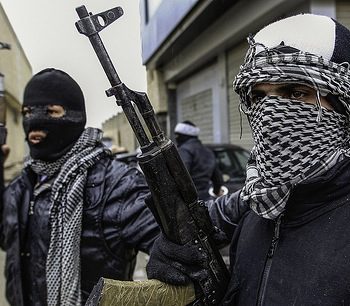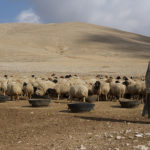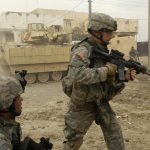Like many leaders in the global jihad, Abu Bakr al-Baghdadi of Al Qaeda in Iraq (AQI) communicates important decisions online.1
In April, he posted an audio recording declaring a merger between AQI and Jabhat al-Nusra (also known as the Al-Nusra Front), the most notoriously violent militant group in Syria and a key player in the rebellion against the Assad government. Baghdadi announced that Jabhat al-Nusra was an extension and part of the Islamic State of Iraq (another name for AQI) and renamed the group the Islamic State of Iraq and the Levant (ISIL).(a)
Though Jabhat al-Nusra’s leader, Abu Mohammad al-Julani, objected to the merger, the truth is that al-Nusra has always been intimately connected with AQI. Its entire structure is shot through with AQI affiliates. Julani himself is a veteran of the conflict in Iraq, as are countless lower-level jihadists who come from former AQI leader Abu Musab al-Zarqawi’s extensive network.(b)
As Baghdadi, the AQI leader, explained in his now infamous video, “Julani… is one of our soldiers, and with him a group of our sons, and we pushed them from Iraq to the Levant… We laid for them plans, and drew up for them the policy of work, and gave them what financial support we could… and supplied them with men who had known the battlefields of jihad.” In its makeup, funding, and tactics, al-Nusra is almost entirely a product of Iraq.2
Though al-Nusra is decidedly smaller than the primary rebel faction, the Free Syrian Army, it has become one of the more effective resistance groups in Syria.(c) A reporter from The Guardian witnessed AQI member Abu Salam al Faluji explain the distinction to his fighting unit in Syria: “The [Syrian] rebels are brave but they don’t even know the difference between a Kalashnikov bullet and a sniper bullet… they have no leadership and no experience.”
Jihadists from Iraq, in contrast, received an unprecedented military education, testing their mettle against the most advanced army in the world.3 They perfected new tactics and forged new alliances. Now veterans of the war are flowing across Iraq’s porous borders to new fronts in the “global jihad,” like Syria.(d) They are sharing ideas and techniques with Syrians as well as the 6,000 foreigners fighting in the Syrian conflict, including 600 fighters from Europe, North America, and Australia.
Perhaps the most critical export from Iraq-based terrorist groups comes in the form of tactical innovation. Jihadi fighters spent nearly a decade developing powerful techniques and testing their efficacy against the U.S. military. Many of today’s textbook terrorist tactics were cultivated during the war, such as the sophisticated dissemination of jihadi propaganda through the internet, the widespread use of car bombs and vehicle-born improvised explosive devices (VBIEDs), and extensive campaigns of suicide attacks.3
For example, after militants in Iraq began using suicide attacks with increasing frequency between 2003 and 2005, the technique spread to neighboring countries like Pakistan and Afghanistan. Before 2005, Afghanistan was virtually free of suicide attacks, but by 2010, it experienced more than Iraq itelf.3 The tactic has also spread to Syria, where Jabhat al-Nusra has claimed responsibility for 57 of 70 suicide bombings reported between December 2011 and April 2013.
Iraq is also where terrorists refined the use of car bombs and vehicle-born improvised explosive devices (VBIEDs). In the first 12 months after the U.S. invasion, there were 19 reported VBIEDs in Iraq. This number increased at a staggering rate over the next few years: there were 54 attacks in 2004, 82 in 2005, 101 in 2006, and 204 in 2007. By the end of the war, 61% of VBIED and car bomb attacks worldwide occurred in Iraq.3
Then car bombs, like other tactics developed in Iraq, spread beyond the country’s borders. Terrorist actors throughout the region now use vehicle-born attacks much more frequently than they did before the war, although the number of attacks both in Iraq and worldwide has declined since its peak in 2007.4 In Syria, militant groups like al-Nusra have set off dozens of car bombs since the conflict began. According to the New York Times, the technique has “frightened and enraged… government supporters and opponents alike” because it indiscriminately kills so many unarmed civilians.
The extensive involvement of Iraqi militants and their techniques in the Syrian conflict indicates that the impact of terrorism fostered by the war stretches well beyond Iraq’s borders. An Al Qaeda strategist, the Syrian-born Mustafa bin Abd al-Qadir Setmariam Nasar, claimed that the war in Iraq almost single-handedly rescued the jihadi movement.(e) Another leading Islamist, Kamal Habib, remarked that though the U.S. supposedly invaded Iraq to eliminate Al Qaeda, it actually “succeeded in reviving a dormant Al Qaeda and the global jihad movement.”
It is the spread of this jihadi movement that continues to haunt the region. The veterans who survived Iraq pose a far more serious threat to international security than those who emerged from the Afghan war of the 1980s and formed the basis of the original Al Qaeda organization.(f) Now Syria itself is becoming the new training ground for jihad, with 6,000 foreign fighters from across the region sharing ideas and tactics, and potentially perpetuating a vicious cycle.
This article is part of a series turning an academic lens on current social, political, and economic events in Syria.
Endnotes
- For a brief background and history of Al Qaeda in Iraq, see: Jonathan Masters (2013) “Al-Qaeda in Iraq (a.k.a. Islamic State in Iraq and Greater Syria),” New York: Council on Foreign Relations.
- For background on Jabhat al-Nusra and a review of its connections to AQI, see: Noman Benotman and Roisin Blake (2013) Jabhat al-Nusra: A Strategic Briefing, London: The Quilliam Foundation.
- Jessica Stern and Megan K. McBride (2013) “Terrorism after the 2003 Invasion of Iraq,” Brown University: Costs of War, Eisenhower Study Group.
- While car bomb attacks in Iraq have dropped nearly 70% since 2007, attacks worldwide have dropped only 49% (Stern and McBride 2013).
Sidenotes
- (a) The Levant is a term for the region on the eastern coast of the Mediterranean Sea between Turkey and Egypt. It primarily consists of Syria, Lebanon, Jordan, Israel, Palestine, and Cyprus.
- (b) Following Baghdadi’s announcement, Julani posted an audio recording saying he had never agreed to the merger, though many of his followers defected to ISIL anyway. Al Qaeda’s top leader, Ayman al-Zawahiri, intervened in June by declaring that al-Nusra should stay separate, with Julani and Baghdadi maintaining their respective leadership roles. Baghdadi has since rejected this order.
- (c) Numerous distinct groups make up the Syrian opposition. The BBC provides an excellent breakdown of the political and military forces working to overthrow President Bashar al-Assad.
- (d) Many Free Syrian Army soldiers have switched over to al-Nusra because it is tactically and organizationally more effective or because they’re drawn to its Islamist ideology. Recently, though, tensions have been escalating between jihadi fighters and the more moderate Syrian opposition. In July an Islamist rebel believed to be from Iraq shot and killed a senior commander of the Free Syrian Army, enraging Syrian rebels and adding considerable fuel to what the BBC calls “a civil war within a civil war.”
- (e) Also known as Al Suri, Nasar is the intellectual architect of al Qaeda’s shift from a bureaucratic organization helmed by a charismatic leader to a global coalition of groups inspired by a movement.
- (f) Jabhat al-Nusra isn’t the only Syrian militant group influenced by terrorist activities in Iraq. Fatah al-Islam (FAI), originally founded in a Palestinian refugee camp by Shakir al-Absi and now involved in the Syrian conflict, has borrowed heavily from the repertoire of tactics AQI developed and refined in its anti-American efforts.





